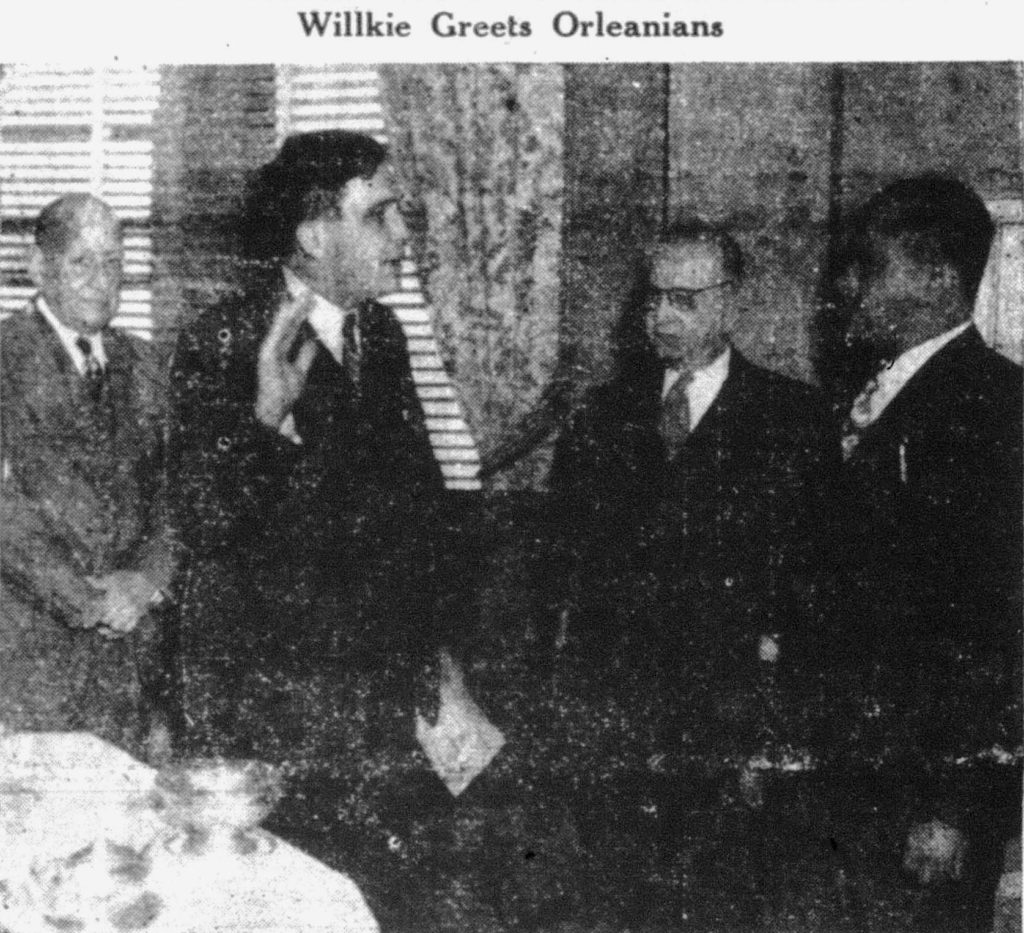
Wendell Willkie Greets Dr. Joseph A. Hardin, James Lewis, Jr., and Alonzo B. Willis – Photo taken by Alden W. Bynum
Before the current pandemic, the nation’s attention was turned to the presidential primary elections and the national party conventions. Every four years, the American people eagerly rally around the candidates of their choice who will eventually vie for the highest office in the land. Three-quarters of a century ago, in 1944, the country was still in the midst of the Second World War and the three-term incumbent, President Franklin Delano Roosevelt, sought an unprecedented fourth term as head of state and commander-in-chief. Ten men sought the Republican nomination that year, among them was Wendell L. Willkie. Willkie, the Indiana-born corporate attorney with his unpretentious manner and unruly hair, had secured the Republican nomination in 1940, after having only been a Republican officially for six months. Willkie rose to popularity in his fight against the Tennessee Valley Authority and his push for American involvement in World War II.
From November 19 to 22, 1943, Willkie visited New Orleans as he once again sought out the nomination of the Republican party. His busy itinerary included a dinner and reception with the state’s Republican leadership; a luncheon at the New Orleans Country Club; a tour of the Port of New Orleans; and even attending a Tulane-LSU game at the invitation of the president of Tulane University. One meeting during Willkie’s visit evaded coverage in the newspapers other than the Black press. On Saturday, November 20, 1943, Willkie met with Dr. Joseph A. Hardin and James Lewis, Jr., colored stalwarts in the Republican Party, and Alonzo B. Willis and Alden W. Bynum of the city’s Sepia Socialite newspaper. The men were met at the front entrance of the Roosevelt Hotel by John E. Jackson, Republican National Committeeman for Louisiana, and took the passenger elevator to Willkie’s suite. It was observed that in the past, Negroes had been refused entry through the front of the building or forced to use the freight elevator. Editor Alonzo Willis had set-up the meeting with Willkie on the condition that it could be arranged “without embarrassment to either of us.” The meeting was considered a success and was lauded as “the most point-blank, face-the-facts discussion of world and racial affairs ever entertained in the South by a presidential aspirant.” Dr. Hardin and Mr. Lewis were ideal representatives to meet with a contender for the presidency, both men had met every Republican President since Theodore Roosevelt. Dr. Joseph Arthur Hardin was a physician and civic leader, who was a delegate from Louisiana to six Republican National Conventions and who served as Consul to Liberia from 1940 to 1953. James Lewis, Jr. was also a delegate at-large and secretary of the Orleans Parish Republican Executive Committee. He was president of the People’s Industrial Life Insurance Company from 1935 until 1950.
During the meeting the demonstrative Willkie unequivocally declared: “I will fight and I’ll pull no punches. I despise the word tolerance – the attitude of granting something because one occupies a superior position. It is a question of basic American rights only.” These words were not mere prattle from a man who a year before had become the first presidential contender to address a convention of the NAACP. He published articles on race relations in the Saturday Evening Post and Collier’s Weekly and was the literal poster boy of the National Urban League’s Campaign for Negro Workers. Willkie utilized position as chairman of Twentieth Century Fox to work with Walter White, NAACP Executive Secretary, to lobby Hollywood for more positive portrayals of blacks in film. It is no surprise then that Dr. Hardin and Mr. Lewis both considered Willkie the “most straightforward, outspoken, and genuine friend of Negroes” since Theodore Roosevelt. Wendell Willkie’s second bid for the White House was short-lived and he returned to private life for only a few months before his death of heart disease at fifty-two years old on 8 October 1944. On the first anniversary of his death, the building which housed the headquarters of the NAACP in Manhattan was named the Wendell Willkie Memorial Building.
Sources: “Southern Prejudice Will Be Gradually Overcome,” The New Orleans Sentinel, 27 November 1943, p. 1,7; “Willkie Arrives for 3-Day Visit,” The Times-Picayune, 20 November 1943, p. 1,2; “Southern Prejudice Fading,” The Pittsburgh Courier, 4 December 1943, p. 1,4; David Levering Lewis, The Improbable Wendell Willkie (New York: Liveright Publishing, 2018), xiv-xv, 212-223.
Jari Honora


